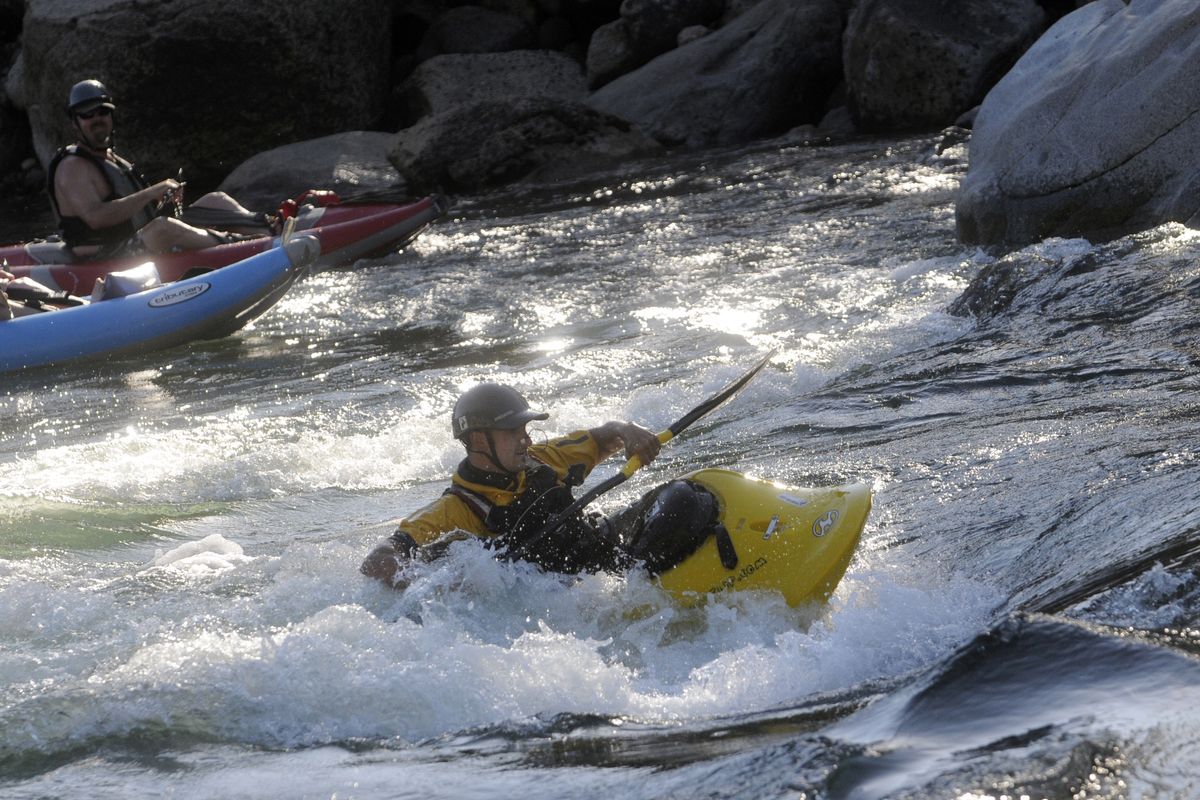Aspiring kayakers can learn to enjoy what river offers

Steve Bailey grew up with a fear of the Spokane River and its deceptive mix of currents and eddies.
“I think most of the people I grew up with were raised to fear the river,” said Bailey, an EMT and a lieutenant in the Spokane County Fire Department. “The water is deceptively fast, and if you don’t understand it, you learn to fear it.”
That changed when Bailey took up kayaking. For the past seven years he’s been a certified instructor, teaching others how to respect and enjoy the river.
This year, with most area rivers and streams running high, Bailey and his friends have enjoyed exceptional kayaking conditions on the river.
“If you know what you’re doing and if you have the necessary experience,” this has been a great spring and summer on the river, he said. “I’ve been fortunate to be able to kayak in some pretty incredible places – from New Zealand to Norway – and Spokane is unique in that some great kayaking is so accessible. You don’t have to drive a long way to get to good water.”
The people you read about getting into trouble on the river, he added, are people who don’t have that necessary equipment.
“You see folks go out and buy a secondhand kayak and go straight for the river,” Bailey explained. “You know, in a lot of ways a kayak is counterintuitive. If it feels like you need to go right, you probably should go left. If you think about it, a kayak’s most stable position when you’re in it is upside down. It’s not the kind of sport you can go off and learn on your own. You need instruction from a qualified teacher.”
The good news, he said, is that the amount of instruction needed to enjoy the stretch of the Spokane River that runs through Spokane Valley is only seven or eight hours.
“The first couple of hours of instruction for someone brand-new to the sport is done on still water – no current at all,” Bailey said. “You need to learn how to handle it, how to right it – you need to get a good feel for it.
“You get that under you and you can get out on some great sections of the river. The Spokane River is considered a Class 2 (rapids) and Class 3 river. The stretch through the Valley is pretty much all Class 2. The Class 3 stretch comes below Spokane Falls and includes the Bowl and Pitcher.”
Bailey was first introduced to the sport in 2002 and he’s been in love with it since.
“I was one of those types who didn’t really like taking classes,” he laughed. “Once I got some basic instruction I just headed to the water. I was fortunate to find a community that was very accepting of a new guy. People came up to me and introduced themselves. They kept an eye on me and helped me out when I got into trouble.
“I think that’s one of the great things about this sport. The people you meet all care about the sport, they care about the river and its environment and about protecting the sport.”
Bailey introduced his wife, Kristy, to kayaking and the couple spends as much time on the water as possible.
“I live along the river, so I’m out here all the time,” he said. “We have a 1-year-old son and he’s down by the river all the time, too. He wears his life jacket, of course. I wish more people could see just how beautiful the Spokane River is and what a magnificent resource it really is.”
Bailey supports the efforts to create the state’s first white-water park on the river below Spokane Falls – a joint effort between kayakers and the Friends of the Falls.
“It’s a long process, and since we want to make sure we protect the river at the same time, there are a lot of parts to the process that just have to take time to make sure they’re done properly. It was part of this process where we discovered red trout in the river, for example.
“The last thing we want to do is create a white-water area for recreation and upset habitat for any of the animal species that live along that section of the river. It’s been a long process and it’s going to take a while longer to make sure it’s done right.”
Kayaking is not an inexpensive sport to get into, Bailey said. A kayak for a serious enthusiast will run about $1,000. Quality paddles can run between $300 and $400. The right protective clothing for being in the river during, say, the month of February gets pricey as well.
“It’s not cheap, but you can do your research and try out a lot of equipment – in fact, that’s what I recommend to all of the people I teach,” he said. “The right kayak for you is a very personal thing, so I always recommend that people try out a lot of different types – and you can rent them all locally.”
It’s worth it – especially from the health standpoint, he said.
“You wouldn’t think it from just watching from the shore, but you get a pretty incredible leg workout when you’re paddling a kayak,” Bailey said. “You’re always using your legs to counter what you do with your arms. You get a great workout for your arms while you paddle, of course. But it’s a great workout for your back and abs.
“If you stop and think about it, it’s a lot like sitting on an exercise ball for a couple hours with your legs up and working your arms. After a couple hours of paddling, I’m pretty tired. But it’s a good tired.”